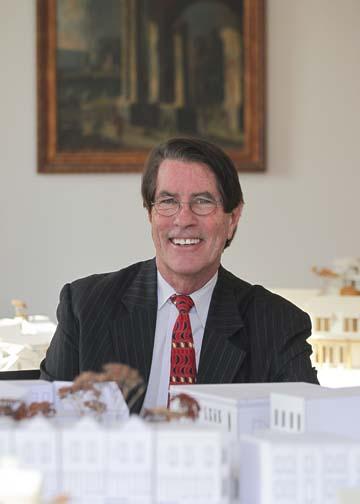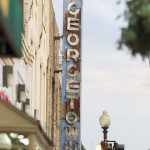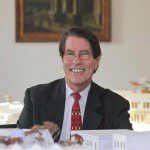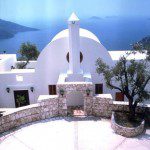When architect Robert Bell announced that he was purchasing the old Georgetown Theater property last October, one got the sense that the man and the place were made for this moment.
Bell, who has worked on projects from Georgetown to Turkey, has his office at 3218 O St., NW, close to the former theater at 1351 Wisconsin Ave., NW, at the intersection of O and Wisconsin.
He has already redeveloped and owns buildings next to his office property. Before the theater property redevelopment is completed, Bell wants to relight its iconic neon “Georgetown” sign by July 4, pending approvals.“I never thought I would see this day come,” Bell told the Georgetowner in October. “It’s a miracle.” He worked with the previous owner, the Heon family, which bought the theater in 1949 and put it up for sale in 2010 for about $4.5 million.
Angie Heon Nys said of Bell: “I had seen the other projects he had done on O Street and was very impressed with his vision and talent. Since I have known him, he has taken a special interest in our property and has put quite a lot of time and energy into his plans. I think the direction he is going in will bring new-found life to that part of Wisconsin Avenue and when he is finished Georgetown will be proud to have it as its landmark.”
Of Nys, Bell replied: “Without her, the deal would not have happened. ”
Bell has said the rejuvenated property will include retail and office space and residences. With the ability to enhance or add windows, the space can have lots of light. The architect also said the property will have much more usable space and will use only one-third of the energy previously used. That’s for a lot described as “6,569 square feet with parking and a carriage house in the rear.” He also envisions a wider sidewalk for that block.
“The basic commitment is contextual architecture wherever I practice it, whether it is in Turkey or Georgetown,” said Bell, who has had to redesign the back of the property after the Old Georgetown Board review called for less space for an intended residence.
Some neighbors on Dumbarton Street and O Street were upset about a planned back addition and the height of an outside wall.
At a November advisory neighborhood commission meeting, one neighbor said Bell was lying about the wall’s height. Christian Mulder, who lives adjacent to the property on Dumbarton Street, said of the latest design changes: “We are happy that the carriage house will be restored, but we are unhappy that an illegal garage that has been a hazard for years is going to be built up two stories and an inner courtyard turned into some half housing project with a loggia. If Bell can build like this, all of Georgetown should be able to build like this. But that would be at the detriment of all of us residents, as the neighborhood would lose character and livability. “In essence,” Mulder continued, “the project remains one of commercial sprawl – no major reductions in the proposal of the main building have been made. The theater building will be massively built up into a four-story colossus. It will have apartments overlooking over people’s gardens. It has a roof and side that is not at all in line with adjacent buildings.”
Bell will face new comments on his redesigns at the Feb. 3 ANC meeting and the Feb. 6 OGB meeting. He seems unfazed, moving on after each design tweak – indeed, his passion for the project and his art is infectious. After all, his firm’s motto is from a quote by the poet Alexander Pope: “Consult the genius of place.” Explained Bell: “I don’t need to do architecture for a living. I am only doing projects which are interesting because they address the biggest issues of today and which is to make a sustainable environment, while preserving and enriching the uniqueness of each place in the world. That uniqueness is both the particular place and its history.”
“That is why the two projects which I am presently pursuing are passive house designs where I am pushing the envelope of technology to consuming zero energy; or community scale projects, such as transforming streets and alleys to the vision of a densification which is just another part of the same principle of making the planet sustainable by stopping urban sprawl to preserve nature and farms,” he said.
As far as his latest project goes, Bell said: “The Georgetown Theater [property] embodies all of these aspects of design – saving the historic and unique character of Georgetown, designing it with passive house characteristics to minimize energy consumption as a model of what can be done in a historic district, densifying the multi-use quality of the building by substantially increasing the use of the existing building, the commitment to making alleys, gardens and people spaces, as in Europe, and finally transforming the sidewalk into a place which is not dominated by automobiles but a commitment to a place which works for people and shopping.”
It is a unique project for the 72-year-old Bell who grew up in suburban Denver, Colo., and studied architecture at Yale University. He admires the architect Robert Venturi who pushed back at the tenets of modern architecture. To architect Mies van der Rohe’s dictum, “Less is more,” Venturi responded: “Less is a bore.”
“When I want to architecture school all there was modern architecture,” Bell said. “Venturi freed students to see traditional architecture just as interesting as modern architecture. I love good architecture. The problem with international architecture is that it is all homogenized. An Apple store looks the same everywhere.”
Bell came to the Washington area to teach architecture at the University of Maryland, applied his craft on Capitol Hill — where he developed condos from an old Peoples Drug building at Lincoln Park — and then moved his business to Georgetown. He and his wife Ann Emmet Bell, who live in Wesley Heights, have five children – Alexa, Rebecca, Bettina, Emmet and Adam — who are older now and have left the nest.
One project the whole family enjoyed was the Solarz house in Kalkan, Turkey. They all got to go with dad. On the Aegean Sea, due east of Rhodes, Greece, the white, sun-drenched “house on the hill” is a far cry from the McLean home, where Bell, years ago, designed a library for the late Rep. Stephen Solarz.
On Volta Place, Bell redesigned the old Georgetown Police Station. It was nice to have Janet Auchincloss, the half-sister of Jaqueline Kennedy, as a buyer, he said. His client — and his children – delighted in the elevator in the middle of a kitchen, which comes out of the ceiling in one of the houses.
At Glover Archbold Park and Hillandale, Bell designed the Palmer residence, next to D.C.’s oldest log cabin. “It looked like something out of Tuscany with donkeys up on the hill,” Bell said of the site that can be seen from Reservoir Road.
Bell and fellow architect Dale Overmyer designed the Johns house on 29th Street. Deb Johns – who said resident concerns about this latest project will be worked out — called Bell “a visionary.” Other projects include a waterfront house in Sherwood Forest near Annapolis and Stonewall Farm.
Nowadays, during an architectural review, Bell finds that “people who were my students are now my judges.” He is complimentary of the OGB, saying it has “great architects.”
A design concept Bell learned at Yale has served him well these days: there is order with some resistance — “something caused a pearl, created by a problem.” That’s what is meant by “genius of the place.” That’s how Bell sees some of those who objected to his original designs for the old theater building. He called his neighbors his “zen masters.”
When asked about other local architects, Bell said he was not necessarily a big fan of architects Hugh Jacobsen and Arthur Cotton Moore. And he did not like Frank Gehry’s Eisenhower memorial or the architecture of the former Shops at Georgetown Park. “There is a balancing act between all of history or just valuable history,” Bell said. “It is a struggle over what is appropriate to keep – like taking off the theater’s fake stone.”
“We want to preserve the historical quality,” he said. “It’s making the fabric richer and denser – and the more people the better. Georgetown should be as dense as possible. It’s good for the environment.”
“All this said, the only way I personally can accomplish these goals is to make the Georgetown Theater profitable as a development,” Bell said. “A profitable endeavor not only makes it possible for me to do it as an individual, it can be a model for other ventures to preserve and revitalize cities.”
“I believe cities should always focus on enriching the pedestrian quality – a place where it is a joy to stroll. That is what I want for Wisconsin Avenue and Georgetown.”
- Robert Bell | Tim Riethmiller





